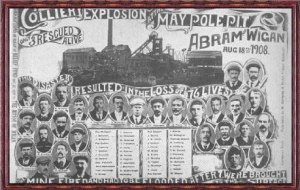This disaster was the third largest loss of life in a British pit disaster and one that occurred less than two years after the West Stanley disaster. There were approximately 2500 men and boys employed by the Hulton Colliery Company at the time of the disaster and approximately 900 would have worked the day shift in five seams on the day of the explosion. The loss of life was actually 349 men and boys, with only 4 survivors coming out of the Pretoria pit alive, as it was known locally. Two of these subsequently died.
The two survivors from the Yard Mine workings were Joseph Staveley, William Davenport. In an account published in the Bolton Evening News Staveley describing what happened to him: “There was a lot of noise…I dropped my kit…The lamps went out and I ran towards the Arley Pit [No.4 shaft]…We were half way there when he [James Berry] stumbled and fell and I fell over him. My head was swimming and I felt very tired. There was no pain. I just wanted to close my eyes and sleep. I was so tired. I went to sleep…At first I thought I was in my bed. I tried to push the clothes from me and touched the body of James Berry. I found I was dressed and it all came back to me. Something had happened. Was I locked in the mine? I called to Berry but he did not answer. I listened for breathing but I heard no sound…I put my can to my mouth and ran. The mine was pitch black. I did not know where I was going”. [he found the water pipes and followed them to the pit eye where he knocked and shouted for the cage to come] “Lower the cage to the Yard Mine…my throat was sore with shouting”. Joseph Staveley, having survived the disaster, also went on to serve in and survive World War I and eventually died in 1954.
The disaster started with an explosion at 7.50am in the Plodder Mine. The official report into the disaster decided that there had been a build up of gas caused by a rockfall the day before and that a damaged safety lamp ignited the gas (methane/firedamp).
As usual in such disasters whole families were devastated; Mrs Miram Tyldesley was perhaps the worst impacted losing her husband, 4 sons and 2 brothers. Such a loss is hardly imaginable nowadays. The disaster occcurred just before Christmas and that year Christmas Day was one of funerals with one diary account talking of funeral processions “criss crossing each other enroute to their denominations”.
Links:
Wikipedia
The Parish of Westhoughton
Staveley Genealogy
Bolton Revisited













